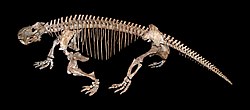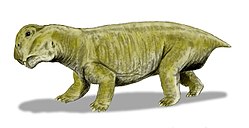| Shansiodontidae Temporal range: Triassic | |
|---|---|
 | |
| Mounted skeleton of Tetragonias njalilus | |
| Scientific classification | |
| Kingdom: | Animalia |
| Phylum: | Chordata |
| Clade: | Synapsida |
| Clade: | Therapsida |
| Clade: | † Anomodontia |
| Clade: | † Dicynodontia |
| Clade: | † Kannemeyeriiformes |
| Family: | † Shansiodontidae Cox, 1965 |
| Genera | |
| |
Shansiodontidae is a family of dicynodont therapsids. [1]





